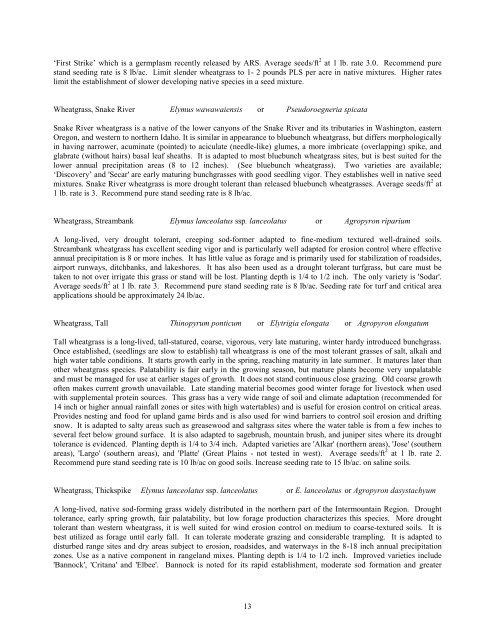Idaho Plant Materials Technical Note No. 24
Idaho Plant Materials Technical Note No. 24
Idaho Plant Materials Technical Note No. 24
You also want an ePaper? Increase the reach of your titles
YUMPU automatically turns print PDFs into web optimized ePapers that Google loves.
‘First Strike’ which is a germplasm recently released by ARS. Average seeds/ft 2 at 1 lb. rate 3.0. Recommend pure<br />
stand seeding rate is 8 lb/ac. Limit slender wheatgrass to 1- 2 pounds PLS per acre in native mixtures. Higher rates<br />
limit the establishment of slower developing native species in a seed mixture.<br />
Wheatgrass, Snake River Elymus wawawaiensis or Pseudoroegneria spicata<br />
Snake River wheatgrass is a native of the lower canyons of the Snake River and its tributaries in Washington, eastern<br />
Oregon, and western to northern <strong>Idaho</strong>. It is similar in appearance to bluebunch wheatgrass, but differs morphologically<br />
in having narrower, acuminate (pointed) to aciculate (needle-like) glumes, a more imbricate (overlapping) spike, and<br />
glabrate (without hairs) basal leaf sheaths. It is adapted to most bluebunch wheatgrass sites, but is best suited for the<br />
lower annual precipitation areas (8 to 12 inches). (See bluebunch wheatgrass). Two varieties are available;<br />
‘Discovery’ and 'Secar' are early maturing bunchgrasses with good seedling vigor. They establishes well in native seed<br />
mixtures. Snake River wheatgrass is more drought tolerant than released bluebunch wheatgrasses. Average seeds/ft 2 at<br />
1 lb. rate is 3. Recommend pure stand seeding rate is 8 lb/ac.<br />
Wheatgrass, Streambank Elymus lanceolatus ssp. lanceolatus or Agropyron riparium<br />
A long-lived, very drought tolerant, creeping sod-former adapted to fine-medium textured well-drained soils.<br />
Streambank wheatgrass has excellent seeding vigor and is particularly well adapted for erosion control where effective<br />
annual precipitation is 8 or more inches. It has little value as forage and is primarily used for stabilization of roadsides,<br />
airport runways, ditchbanks, and lakeshores. It has also been used as a drought tolerant turfgrass, but care must be<br />
taken to not over irrigate this grass or stand will be lost. <strong>Plant</strong>ing depth is 1/4 to 1/2 inch. The only variety is 'Sodar'.<br />
Average seeds/ft 2 at 1 lb. rate 3. Recommend pure stand seeding rate is 8 lb/ac. Seeding rate for turf and critical area<br />
applications should be approximately <strong>24</strong> lb/ac.<br />
Wheatgrass, Tall Thinopyrum ponticum or Elytrigia elongata or Agropyron elongatum<br />
Tall wheatgrass is a long-lived, tall-statured, coarse, vigorous, very late maturing, winter hardy introduced bunchgrass.<br />
Once established, (seedlings are slow to establish) tall wheatgrass is one of the most tolerant grasses of salt, alkali and<br />
high water table conditions. It starts growth early in the spring, reaching maturity in late summer. It matures later than<br />
other wheatgrass species. Palatability is fair early in the growing season, but mature plants become very unpalatable<br />
and must be managed for use at earlier stages of growth. It does not stand continuous close grazing. Old coarse growth<br />
often makes current growth unavailable. Late standing material becomes good winter forage for livestock when used<br />
with supplemental protein sources. This grass has a very wide range of soil and climate adaptation (recommended for<br />
14 inch or higher annual rainfall zones or sites with high watertables) and is useful for erosion control on critical areas.<br />
Provides nesting and food for upland game birds and is also used for wind barriers to control soil erosion and drifting<br />
snow. It is adapted to salty areas such as greasewood and saltgrass sites where the water table is from a few inches to<br />
several feet below ground surface. It is also adapted to sagebrush, mountain brush, and juniper sites where its drought<br />
tolerance is evidenced. <strong>Plant</strong>ing depth is 1/4 to 3/4 inch. Adapted varieties are 'Alkar' (northern areas), 'Jose' (southern<br />
areas), 'Largo' (southern areas), and 'Platte' (Great Plains - not tested in west). Average seeds/ft 2 at 1 lb. rate 2.<br />
Recommend pure stand seeding rate is 10 lb/ac on good soils. Increase seeding rate to 15 lb/ac. on saline soils.<br />
Wheatgrass, Thickspike Elymus lanceolatus ssp. lanceolatus or E. lanceolatus or Agropyron dasystachyum<br />
A long-lived, native sod-forming grass widely distributed in the northern part of the Intermountain Region. Drought<br />
tolerance, early spring growth, fair palatability, but low forage production characterizes this species. More drought<br />
tolerant than western wheatgrass, it is well suited for wind erosion control on medium to coarse-textured soils. It is<br />
best utilized as forage until early fall. It can tolerate moderate grazing and considerable trampling. It is adapted to<br />
disturbed range sites and dry areas subject to erosion, roadsides, and waterways in the 8-18 inch annual precipitation<br />
zones. Use as a native component in rangeland mixes. <strong>Plant</strong>ing depth is 1/4 to 1/2 inch. Improved varieties include<br />
'Bannock', 'Critana' and 'Elbee'. Bannock is noted for its rapid establishment, moderate sod formation and greater<br />
13
















